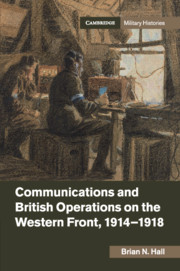Book contents
- Communications and British Operations on the Western Front, 1914–1918
- Cambridge Military Histories
- Communications and British Operations on the Western Front, 1914–1918
- Copyright page
- Dedication
- Contents
- Plates
- Figures
- Tables
- Acknowledgements
- Abbreviations
- Maps
- Introduction
- 1 Organisation
- 2 Personnel, Recruitment and Training
- 3 Means of Communication
- 4 1914–1915
- 5 1916
- 6 1917
- 7 1918
- Conclusion
- Book part
- Bibliography
- Index
- References
Bibliography
Published online by Cambridge University Press: 04 July 2017
- Communications and British Operations on the Western Front, 1914–1918
- Cambridge Military Histories
- Communications and British Operations on the Western Front, 1914–1918
- Copyright page
- Dedication
- Contents
- Plates
- Figures
- Tables
- Acknowledgements
- Abbreviations
- Maps
- Introduction
- 1 Organisation
- 2 Personnel, Recruitment and Training
- 3 Means of Communication
- 4 1914–1915
- 5 1916
- 6 1917
- 7 1918
- Conclusion
- Book part
- Bibliography
- Index
- References
- Type
- Chapter
- Information
- Publisher: Cambridge University PressPrint publication year: 2017



